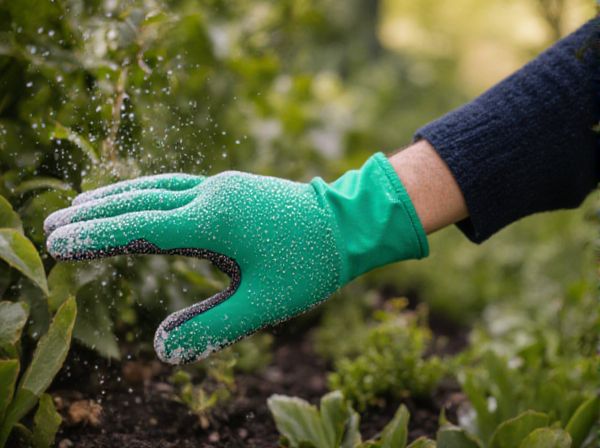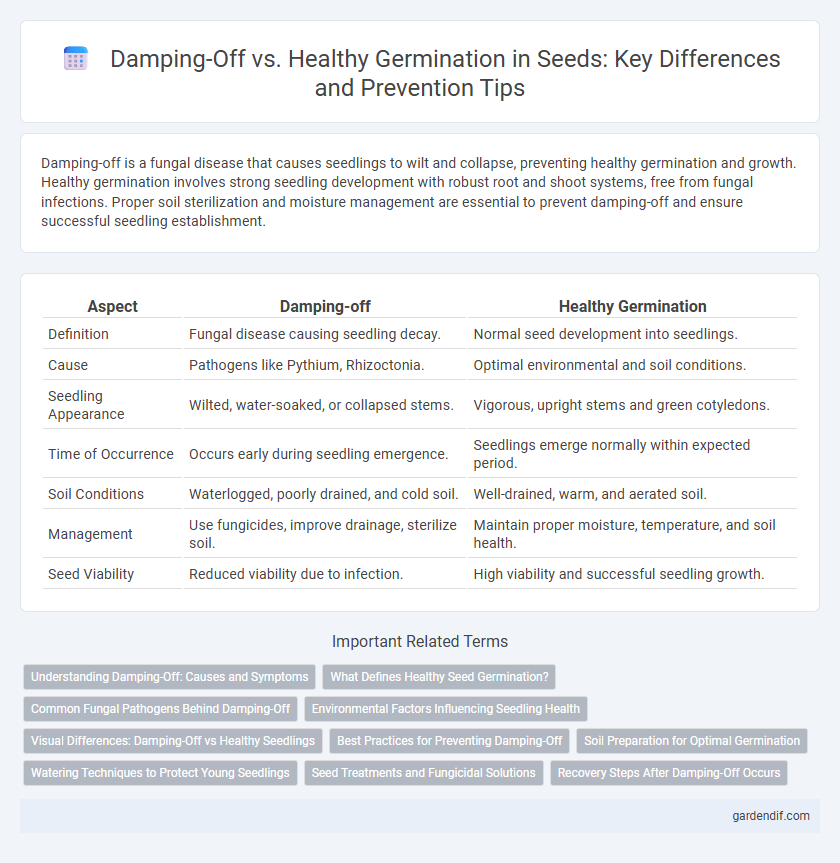
Damping-off vs Healthy germination Illustration
Damping-off is a fungal disease that causes seedlings to wilt and collapse, preventing healthy germination and growth. Healthy germination involves strong seedling development with robust root and shoot systems, free from fungal infections. Proper soil sterilization and moisture management are essential to prevent damping-off and ensure successful seedling establishment.
Table of Comparison
| Aspect | Damping-off | Healthy Germination |
|---|---|---|
| Definition | Fungal disease causing seedling decay. | Normal seed development into seedlings. |
| Cause | Pathogens like Pythium, Rhizoctonia. | Optimal environmental and soil conditions. |
| Seedling Appearance | Wilted, water-soaked, or collapsed stems. | Vigorous, upright stems and green cotyledons. |
| Time of Occurrence | Occurs early during seedling emergence. | Seedlings emerge normally within expected period. |
| Soil Conditions | Waterlogged, poorly drained, and cold soil. | Well-drained, warm, and aerated soil. |
| Management | Use fungicides, improve drainage, sterilize soil. | Maintain proper moisture, temperature, and soil health. |
| Seed Viability | Reduced viability due to infection. | High viability and successful seedling growth. |
Understanding Damping-Off: Causes and Symptoms
Damping-off is a soilborne fungal disease primarily caused by pathogens like Pythium, Rhizoctonia, and Fusarium species, affecting seedlings during germination. Symptoms include stem rot at the soil line, seedling collapse, and poor root development, leading to high mortality rates in young plants. Understanding these causes and early symptoms is essential to prevent damping-off and promote healthy germination for robust seedling growth.
What Defines Healthy Seed Germination?
Healthy seed germination is defined by the successful emergence of a strong radicle and plumule, indicating vigorous seedling development without any signs of fungal infection or decay. Seeds exhibiting uniform germination rates above 85% in optimal conditions typically demonstrate resilience against damping-off pathogens such as Pythium and Rhizoctonia species. Maintaining proper soil moisture, temperature, and sterile seedbed conditions are critical factors to ensure the prevention of damping-off and promote robust germination.
Common Fungal Pathogens Behind Damping-Off
Damping-off is primarily caused by fungal pathogens such as Pythium, Rhizoctonia solani, and Fusarium species, which attack seedlings at the soil line leading to stem rot and sudden collapse. These pathogens thrive in overly moist, poorly drained soils, significantly reducing healthy germination rates by inhibiting root development and seedling emergence. Effective management involves well-drained soil conditions, seed treatments, and crop rotation to minimize fungal inoculum and promote vigorous seedling growth.
Environmental Factors Influencing Seedling Health
Temperature, soil moisture, and air circulation critically influence damping-off incidence and healthy germination rates. Excessive soil moisture and poor drainage create ideal conditions for pathogenic fungi like Pythium and Rhizoctonia to attack seedlings, leading to damping-off. Conversely, well-drained soils, optimal temperature ranges (20-25degC), and adequate airflow promote robust seedling development and reduce disease risk.
Visual Differences: Damping-Off vs Healthy Seedlings
Damping-off seedlings exhibit symptoms such as browning, water-soaked lesions near the soil line, and a weakened, collapsing stem, while healthy seedlings display sturdy, upright stems with vibrant green leaves. Infected seeds often fail to emerge or show stunted growth with yellowing cotyledons, contrasting with the uniform, rapid germination and strong root development seen in healthy seeds. The presence of fungal mycelium or slimy seed coatings further distinguishes damping-off cases from robust, disease-free seedlings.
Best Practices for Preventing Damping-Off
Damping-off, caused by soilborne pathogens like Pythium and Rhizoctonia, results in seedling decay and poor germination rates, whereas healthy germination ensures strong seedling establishment. Best practices for preventing damping-off include using sterile seed-starting media, maintaining proper drainage, and avoiding overwatering to reduce pathogen proliferation. Implementing crop rotation and applying biological fungicides can further protect seedlings and promote vigorous growth.
Soil Preparation for Optimal Germination
Proper soil preparation significantly reduces the risk of damping-off by ensuring well-drained, sterile, and nutrient-rich conditions that promote healthy germination. Incorporating organic matter such as compost improves soil structure, while sterilizing or pasteurizing soil eliminates pathogenic fungi responsible for seedling diseases. Maintaining optimal soil moisture and avoiding overwatering creates an environment where seeds can absorb nutrients effectively without fostering harmful fungal growth.
Watering Techniques to Protect Young Seedlings
Proper watering techniques are crucial to prevent damping-off in seedlings, which is caused by fungal pathogens thriving in overly wet soil. Maintaining consistent moisture without waterlogging supports healthy germination by promoting strong root development and air circulation around the seedling base. Using well-draining soil and watering at the base rather than overhead minimizes fungal growth and enhances seedling survival rates.
Seed Treatments and Fungicidal Solutions
Effective seed treatments and fungicidal solutions play a critical role in preventing damping-off, a fungal disease that causes seedling decay and poor germination rates. Fungicides such as metalaxyl, fludioxonil, and thiabendazole are widely used to protect seeds from soil-borne pathogens like Pythium and Rhizoctonia, ensuring healthy seedling establishment. Applying these treatments enhances seedling vigor, reduces crop losses, and promotes uniform, healthy germination essential for optimal crop production.
Recovery Steps After Damping-Off Occurs
Prompt identification of damping-off in seedlings is crucial to prevent widespread losses in the germination phase. Recovery steps include removing affected seedlings, sterilizing the soil or growing medium, and improving drainage and air circulation to inhibit fungal growth. Applying fungicides and ensuring optimal moisture levels enhance the chances of healthy germination post-damping-off.
Damping-off vs Healthy germination Infographic

 gardendif.com
gardendif.com